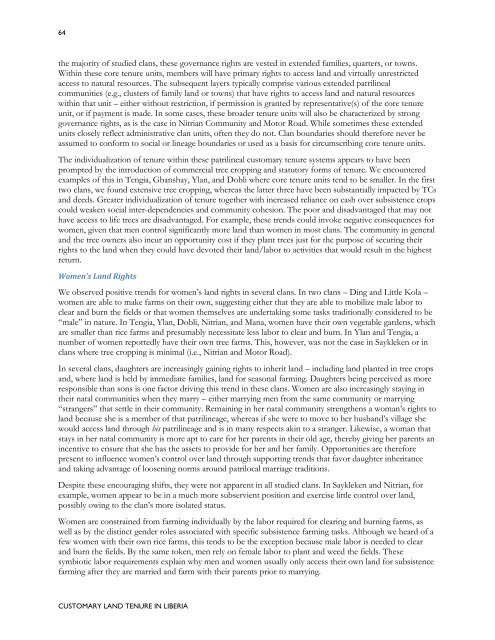Customary Land Tenure in Liberia - Land Tenure and Property ...
Customary Land Tenure in Liberia - Land Tenure and Property ...
Customary Land Tenure in Liberia - Land Tenure and Property ...
You also want an ePaper? Increase the reach of your titles
YUMPU automatically turns print PDFs into web optimized ePapers that Google loves.
64<br />
the majority of studied clans, these governance rights are vested <strong>in</strong> extended families, quarters, or towns.<br />
With<strong>in</strong> these core tenure units, members will have primary rights to access l<strong>and</strong> <strong>and</strong> virtually unrestricted<br />
access to natural resources. The subsequent layers typically comprise various extended patril<strong>in</strong>eal<br />
communities (e.g., clusters of family l<strong>and</strong> or towns) that have rights to access l<strong>and</strong> <strong>and</strong> natural resources<br />
with<strong>in</strong> that unit – either without restriction, if permission is granted by representative(s) of the core tenure<br />
unit, or if payment is made. In some cases, these broader tenure units will also be characterized by strong<br />
governance rights, as is the case <strong>in</strong> Nitrian Community <strong>and</strong> Motor Road. While sometimes these extended<br />
units closely reflect adm<strong>in</strong>istrative clan units, often they do not. Clan boundaries should therefore never be<br />
assumed to conform to social or l<strong>in</strong>eage boundaries or used as a basis for circumscrib<strong>in</strong>g core tenure units.<br />
The <strong>in</strong>dividualization of tenure with<strong>in</strong> these patril<strong>in</strong>eal customary tenure systems appears to have been<br />
prompted by the <strong>in</strong>troduction of commercial tree cropp<strong>in</strong>g <strong>and</strong> statutory forms of tenure. We encountered<br />
examples of this <strong>in</strong> Tengia, Gbanshay, Ylan, <strong>and</strong> Dobli where core tenure units tend to be smaller. In the first<br />
two clans, we found extensive tree cropp<strong>in</strong>g, whereas the latter three have been substantially impacted by TCs<br />
<strong>and</strong> deeds. Greater <strong>in</strong>dividualization of tenure together with <strong>in</strong>creased reliance on cash over subsistence crops<br />
could weaken social <strong>in</strong>ter-dependencies <strong>and</strong> community cohesion. The poor <strong>and</strong> disadvantaged that may not<br />
have access to life trees are disadvantaged. For example, these trends could <strong>in</strong>voke negative consequences for<br />
women, given that men control significantly more l<strong>and</strong> than women <strong>in</strong> most clans. The community <strong>in</strong> general<br />
<strong>and</strong> the tree owners also <strong>in</strong>cur an opportunity cost if they plant trees just for the purpose of secur<strong>in</strong>g their<br />
rights to the l<strong>and</strong> when they could have devoted their l<strong>and</strong>/labor to activities that would result <strong>in</strong> the highest<br />
return.<br />
Women’s <strong>L<strong>and</strong></strong> Rights<br />
We observed positive trends for women‟s l<strong>and</strong> rights <strong>in</strong> several clans. In two clans – D<strong>in</strong>g <strong>and</strong> Little Kola –<br />
women are able to make farms on their own, suggest<strong>in</strong>g either that they are able to mobilize male labor to<br />
clear <strong>and</strong> burn the fields or that women themselves are undertak<strong>in</strong>g some tasks traditionally considered to be<br />
“male” <strong>in</strong> nature. In Tengia, Ylan, Dobli, Nitrian, <strong>and</strong> Mana, women have their own vegetable gardens, which<br />
are smaller than rice farms <strong>and</strong> presumably necessitate less labor to clear <strong>and</strong> burn. In Ylan <strong>and</strong> Tengia, a<br />
number of women reportedly have their own tree farms. This, however, was not the case <strong>in</strong> Saykleken or <strong>in</strong><br />
clans where tree cropp<strong>in</strong>g is m<strong>in</strong>imal (i.e., Nitrian <strong>and</strong> Motor Road).<br />
In several clans, daughters are <strong>in</strong>creas<strong>in</strong>gly ga<strong>in</strong><strong>in</strong>g rights to <strong>in</strong>herit l<strong>and</strong> – <strong>in</strong>clud<strong>in</strong>g l<strong>and</strong> planted <strong>in</strong> tree crops<br />
<strong>and</strong>, where l<strong>and</strong> is held by immediate families, l<strong>and</strong> for seasonal farm<strong>in</strong>g. Daughters be<strong>in</strong>g perceived as more<br />
responsible than sons is one factor driv<strong>in</strong>g this trend <strong>in</strong> these clans. Women are also <strong>in</strong>creas<strong>in</strong>gly stay<strong>in</strong>g <strong>in</strong><br />
their natal communities when they marry – either marry<strong>in</strong>g men from the same community or marry<strong>in</strong>g<br />
“strangers” that settle <strong>in</strong> their community. Rema<strong>in</strong><strong>in</strong>g <strong>in</strong> her natal community strengthens a woman‟s rights to<br />
l<strong>and</strong> because she is a member of that patril<strong>in</strong>eage, whereas if she were to move to her husb<strong>and</strong>‟s village she<br />
would access l<strong>and</strong> through his patril<strong>in</strong>eage <strong>and</strong> is <strong>in</strong> many respects ak<strong>in</strong> to a stranger. Likewise, a woman that<br />
stays <strong>in</strong> her natal community is more apt to care for her parents <strong>in</strong> their old age, thereby giv<strong>in</strong>g her parents an<br />
<strong>in</strong>centive to ensure that she has the assets to provide for her <strong>and</strong> her family. Opportunities are therefore<br />
present to <strong>in</strong>fluence women‟s control over l<strong>and</strong> through support<strong>in</strong>g trends that favor daughter <strong>in</strong>heritance<br />
<strong>and</strong> tak<strong>in</strong>g advantage of loosen<strong>in</strong>g norms around patrilocal marriage traditions.<br />
Despite these encourag<strong>in</strong>g shifts, they were not apparent <strong>in</strong> all studied clans. In Saykleken <strong>and</strong> Nitrian, for<br />
example, women appear to be <strong>in</strong> a much more subservient position <strong>and</strong> exercise little control over l<strong>and</strong>,<br />
possibly ow<strong>in</strong>g to the clan‟s more isolated status.<br />
Women are constra<strong>in</strong>ed from farm<strong>in</strong>g <strong>in</strong>dividually by the labor required for clear<strong>in</strong>g <strong>and</strong> burn<strong>in</strong>g farms, as<br />
well as by the dist<strong>in</strong>ct gender roles associated with specific subsistence farm<strong>in</strong>g tasks. Although we heard of a<br />
few women with their own rice farms, this tends to be the exception because male labor is needed to clear<br />
<strong>and</strong> burn the fields. By the same token, men rely on female labor to plant <strong>and</strong> weed the fields. These<br />
symbiotic labor requirements expla<strong>in</strong> why men <strong>and</strong> women usually only access their own l<strong>and</strong> for subsistence<br />
farm<strong>in</strong>g after they are married <strong>and</strong> farm with their parents prior to marry<strong>in</strong>g.<br />
CUSTOMARY LAND TENURE IN LIBERIA

















